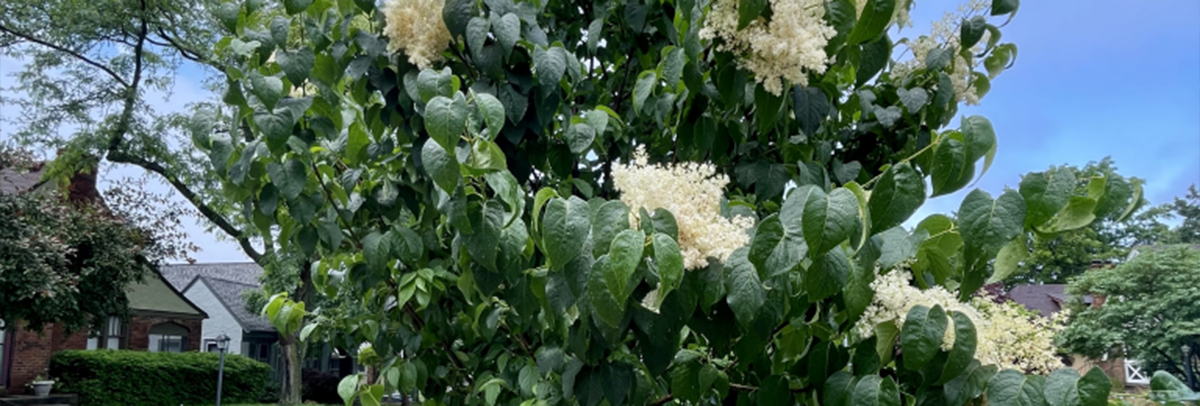It’s finally tree planting season! We must continue to plant trees in our landscapes for the myriad of benefits they provide to the entire land community.
While trees are beautiful, they aren’t just decorations – they benefit human health. Kansas City may face record-high heats in years to come. We must plant trees today so they can become established before then. Their shade will cool us and reduce emissions. Aside from shade, certain trees provide food and habitat for native wildlife (oftentimes humans too) and reduce storm water runoff. We must select trees with this in mind.

Although cities are working hard to plant on public property, more than 90% of Missouri land is private property which means residents have more space to sustain tree coverage. Even if there are already large trees on property, landowners can plant understory species or plant to replace mature trees when they decline.
Successfully using trees to protect environment, wildlife, and human health depends first on proper selection. Native trees have been living and evolving here with other ecosystem species for hundreds of years and should be a priority. Also, since climate is changing, USDA has projected which trees will be most adapted in 2100. Black oak, Eastern red cedar, sycamore, post oak, black willow, common persimmon, sugarberry, pecan and blackjack oak were some of the most suitable. Arbor Day Foundation and Davey Tree recently published a future hardiness zone map based on a similar USDA publication. It predicts that by 2099, Kansas City will be zone 7a or 7b.
Top 4 Tips for Selecting Trees in Kansas City
1. Study your planting site.
- Soil and moisture. Species exist that tolerate dry, moist, wet, flooded, compacted, loamy, clay, sandy, acidic and nutrient-deficient soils. We should choose species found in natural areas similar to our planting site (savanna, upland forests, bottomland forests, glades, etc.) Use the “Plants that Tolerate” function of this search from Missouri Botanical Garden. Unfortunately, many urban soils are compacted, contaminated and left without an organic layer. We plant tough trees like Kentucky coffeetree, hybrid elms and zelkovas in these conditions. Drainage and compaction can be improved with drains, aeration or incorporating organic matter, but it can be difficult. For moisture, try a percolation test: dig a 24-inch deep hole, fill the hole with water, let it drain and fill again. If it drains the second time within 24 hours, drainage should be adequate for most trees.
- What space do you have available? We usually leave 20-30 feet between large shade tree species like oaks, but large trees do grow closer in forest ecosystems and then develop beneficial root relationships. Your approach here depends on if you’re buying one large tree or buying hundreds of seedlings. Smaller trees and shrubs can be added in between large trees, such as redbud, dogwood, serviceberry, hophornbeam, etc. Don’t plant large trees under power lines or in less than 8 feet of planting space.
- Sun, shade, some of both? Trees are available for all sites. Besides fruit trees, not many species require full sun. There is rarely full shade in our urban environment, so shade-intolerant species that may struggle in deep forest can still grow. Look to natural spaces, forests and woodlands, for inspiration on where trees want to be. Resources below list preferred sun conditions.
- Microclimates. Your site may have unique conditions based on slope, exposure to wind, etc. If you are planting by the house on the south side, a tree may experience more heat than just around the corner on the same property. If you had a pile of gravel sitting on your planting site for years, the soil may be compacted just there.
2. Determine your goals.
We hope your goals will be environmental or health conscious, like supporting wildlife, pollinators, food access, erosion prevention or large trees for shade and maximum carbon sequestration. Many of those ecological goals will be accomplished by choosing native trees (also known as “true” or “straight” species), not cultivars or near-natives. However, other goals exist like those for aesthetic landscape value like bright spring flowers or fall leaf color.
3. Choose diversity!
We learned a hard lesson after lining streets with elm (Dutch elm disease), ash (emerald ash borer) and now red maple (Asian longhorned beetle). Although traditional landscape design principles like unity, repetition and focal points may lead some to plant monocultures, we know it is not the healthy or sustainable choice. If trees are all the same, they are vulnerable to the same pests and diseases. They attract the same fungi and bacteria, they have the same root structure and mine soil for the same nutrients. Studies show that diverse landscapes improve human health and root networks of polycultures create symbiotic relationships in the soil.
4. Inspect planting stock

If you purchase containerized trees, avoid trees with circling roots, which could become girdling roots or reduce stability of the tree. If you purchased balled and burlapped trees, make sure the soil ball is moist and stays intact. Trees should be free of damage, disease and over-pruning. Look for trees with good trunk taper and one main trunk.
Free Trees: Rather than paying for and planting trees, consider selectively thinning the volunteer trees that pop up in your yard. Tie a ribbon on trees to be kept, mulch them and mow around them. Oaks, redbud, hackberry, catalpa, sycamore, cottonwood, black walnut, eastern red cedar, mulberry and others spring up often in sites they prefer.
Trees for Kansas City
There are seemingly countless recommended tree lists, and we include some at the bottom. We’ve provided here trees that 1) Heartland Tree Alliance and steering committee members have had success planting in our urban environment recently and 2) trees which meet ecological goals but we can’t or do not plant along streets for various reasons.
- We did not include evergreen trees. We appreciate shortleaf pine and Eastern red cedar.
- We did not include fruit trees. Orchards and food forests are critically important to an edible ecosystem solution to food access and self-sufficiency, but we defer to Kansas City Community Gardens and Giving Grove. Check out KCCG’s tree list to prepare for ordering this winter. More recommendations here.
- We did not include shrubs. We stuck to tree-form plants (one main trunk). However, shrubs are often underutilized in the landscape. Spicebush, hazelnut, witch hazel and aronia are some beneficial natives that come to mind. Native serviceberry and lilacs naturally grow in shrub form too.
Note on Natives: Not all trees listed are native species. Some cultivars are selected because they have persistent fruit, no fruit or are especially tolerant of urban soil conditions.
Robert Whitman, Vice President and Landscape Architect at Multistudio, is a long-time member of our steering committee and delivers the species selection portion of our TreeKeeper course. He prioritizes using oaks in landscape design when possible because they are native to our local ecosystem. Oaks support more than 500 species of moths and butterflies, providing food for birds and other wildlife.
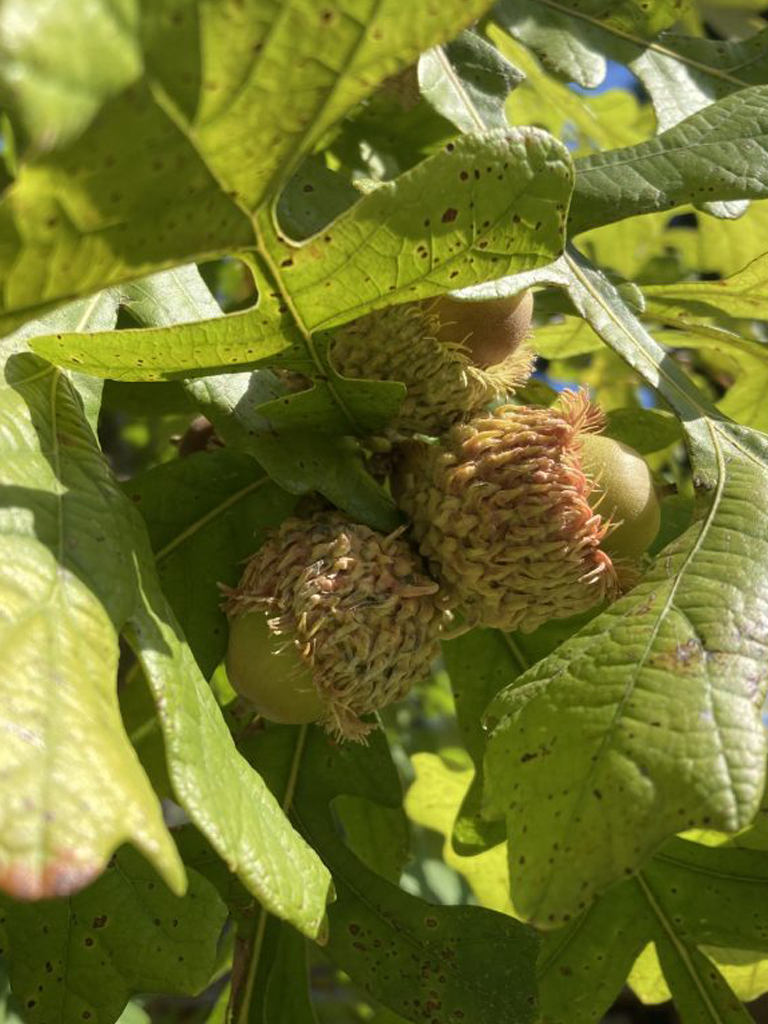
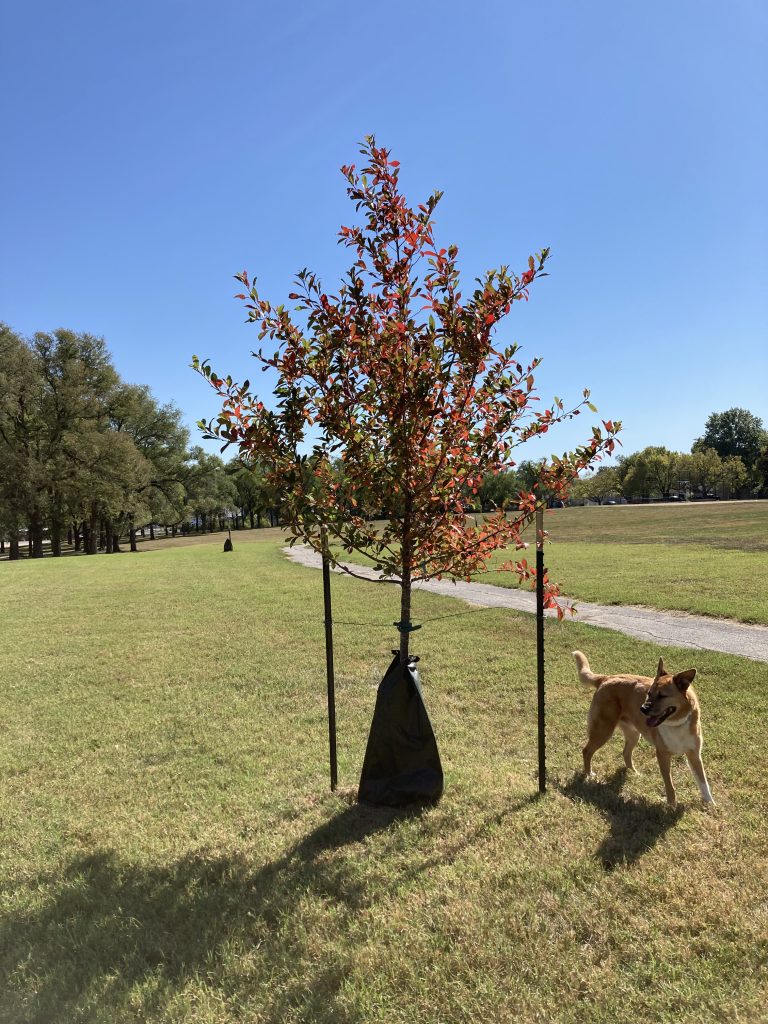
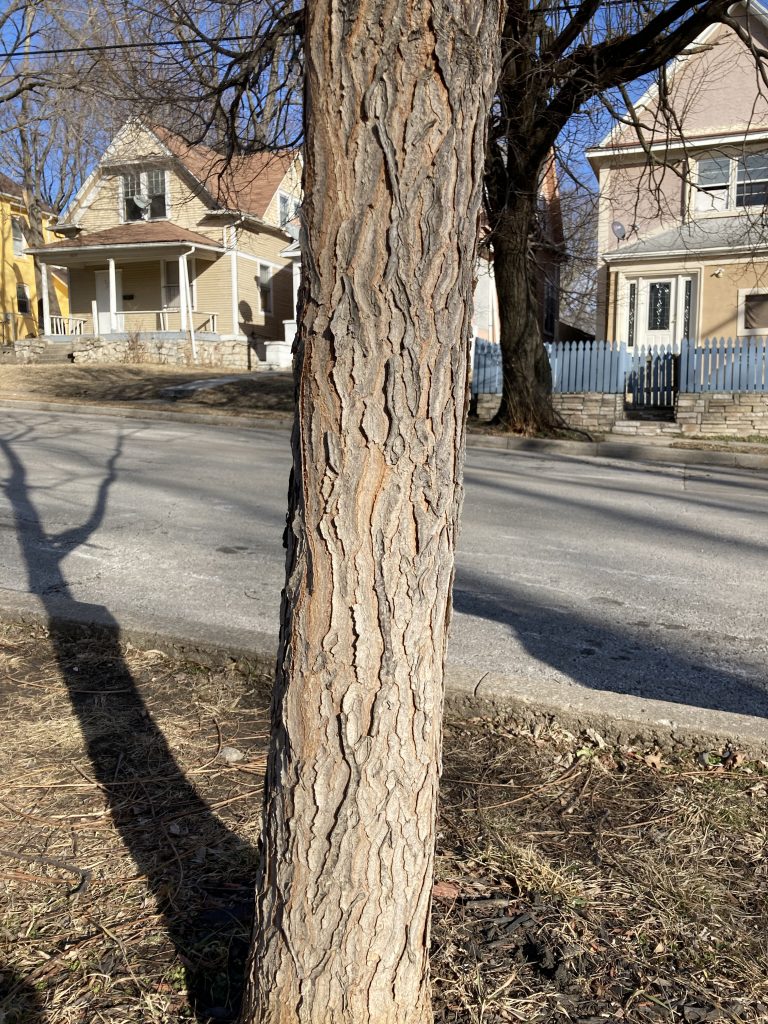
Shade trees:
| Common name | Scientific name | Native | Street Tree |
| Swamp white oak | Quercus bicolor | Yes | Yes |
| White oak | Quercus alba | Yes | Yes |
| Bur oak | Quercus macropcarpa | Yes | Yes |
| Chinkapin oak | Quercus muehlenbergii | Yes | Yes |
| Post oak | Quercus stellata | Yes | Yes |
| Northern red oak | Quercus rubra | Yes | Yes |
| Shumard oak | Quercus shumardii | Yes | Yes |
| Pacific sunset maple | Acer truncatum x A. platanoides ‘Warrenred’ | No | Yes |
| Hickories | Carya spp. | Yes | Maybe |
| Pecan | Carya illinoinensis | Yes | No |
| Northern catalpa | Catalpa speciosa | Yes | No |
| Sugarberry | Celtis laevigata | Yes | Yes |
| Hackberry | Celtis occidentalis | Yes | Yes |
| Common persimmon | Diospyros virginiana | Yes | No |
| Kentucky coffeetree | Gymnocladus dioicus | Yes | Seedless variety |
| Black walnut | Juglans nigra | Yes | No |
| Tulip tree | Liriodendron tulipifera | Yes | Yes |
| Red mulberry | Morus rubra | Yes | No |
| Blackgum | Nyssa sylvatica | Yes | Yes |
| Bald cypress | Taxodium distichum | Yes | Yes |
| American linden | Tilia americana | Yes | Yes |
| American elm | Ulmus americana ‘Princeton’ | No | Yes |
Free Trees: We plant city street trees when nearby residents agree to help water the tree(s) planted near their property. These trees are between 6-10 feet tall at time of planting, are worth around $450 each, and residents help select species. Sign up now: treesformycity.org.
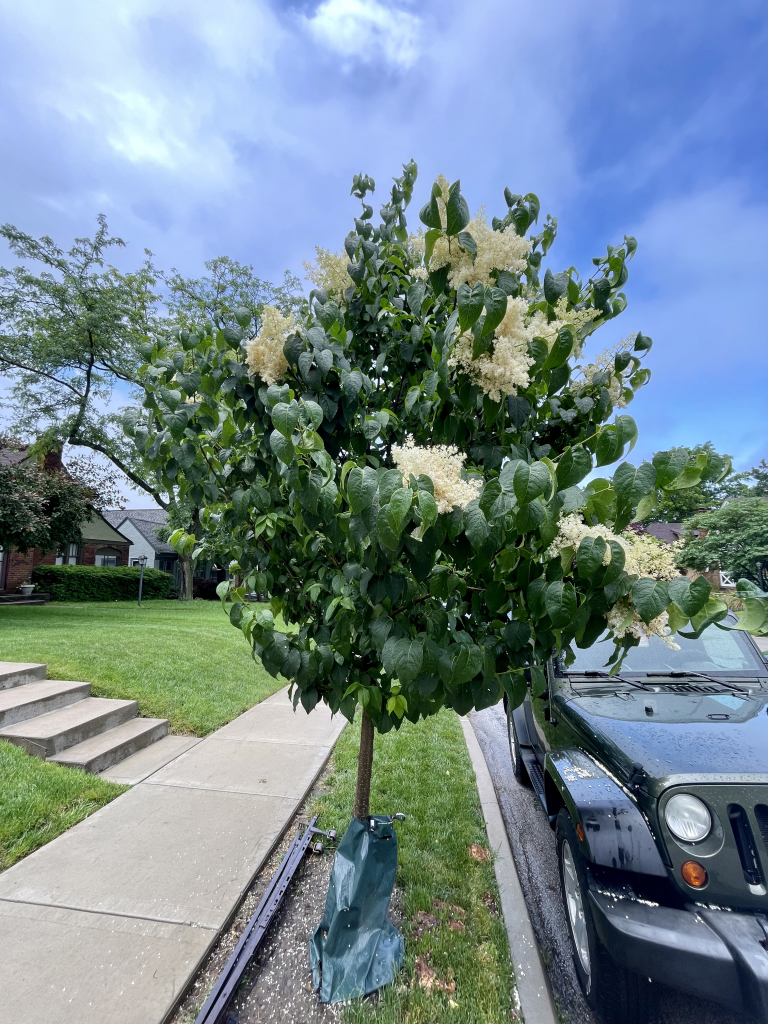
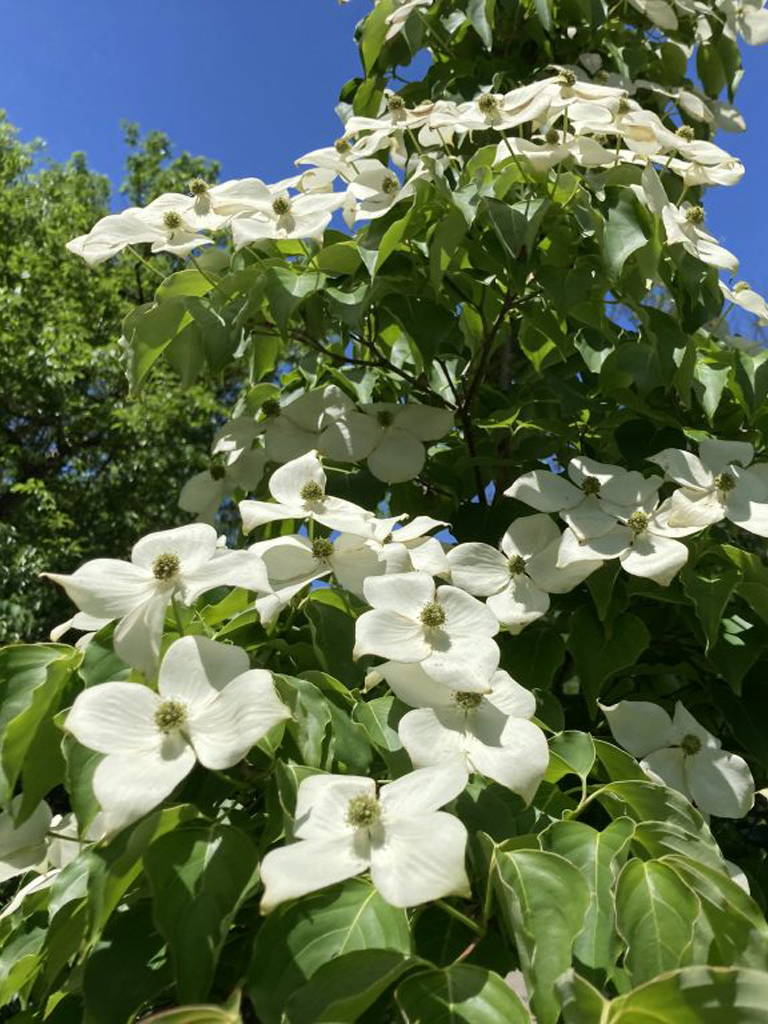
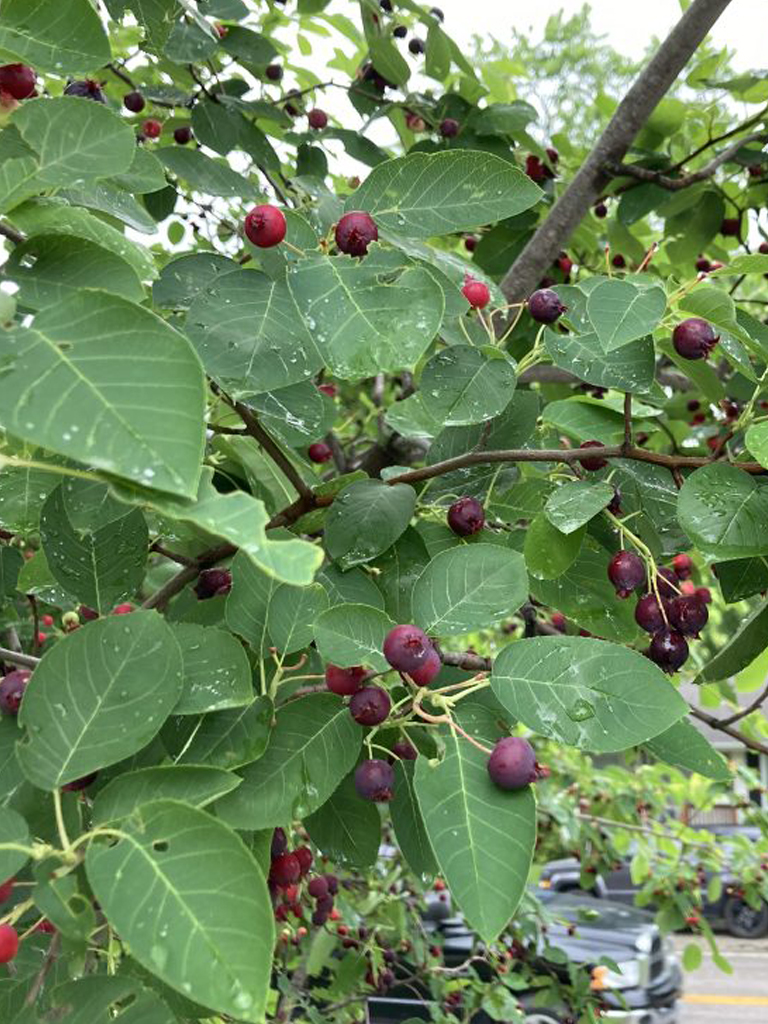
Small trees:
| Common name | Scientific name | Native | Street tree |
| Tartarian maple | Acer tataricum | No | Yes |
| Shantung maple | Acer truncatum | No | Yes |
| Paperbark maple | Acer griseum | No | Yes |
| Serviceberry | Amelanchier x grandiflora ‘Autumn Brilliance’ | No | Yes |
| Pawpaw | Asimina triloba | Yes | No |
| American hornbeam | Carpinus caroliniana | Yes | Yes |
| Eastern redbud | Cercis canadensis | Yes | Yes |
| Kousa dogwood | Cornus kousa | No | Maybe |
| Royal raindrop crabapple | Malus x ‘JFS-KW5’ | No | Yes |
| Hophornbeam | Ostrya virginiana | Yes | Yes |
| Wild plum | Prunus americana | Yes | No |
| Ivory silk lilac | Syringa reticulata ‘Ivory Silk’ | No | Yes |
FIND SPECIES:
Great Trees for the Kansas City Region
Study by Robert Whitman, ASLA, AICP, LEED AP
Climate Change Tree Atlas
USDA Forest Service
Native Plant Database
Missouri Prairie Foundation
Plant Finder
Missouri Botanical Garden
Native Trees for Missouri Landscapes
Missouri Botanical Garden
Missouri Urban Trees (Tree Species Suitable for Special Conditions on page 8)
Missouri Department of Conservation
WHERE TO BUY:
Grow Native! Resource Guide
Missouri Prairie Foundation
Tree Seedling Order Form (Missouri)
Missouri Department of Conservation
Tree Seedling Order Form (Kansas)
Kansas Forest Service
Tree Seedling Order Form
Arbor Day Foundation

